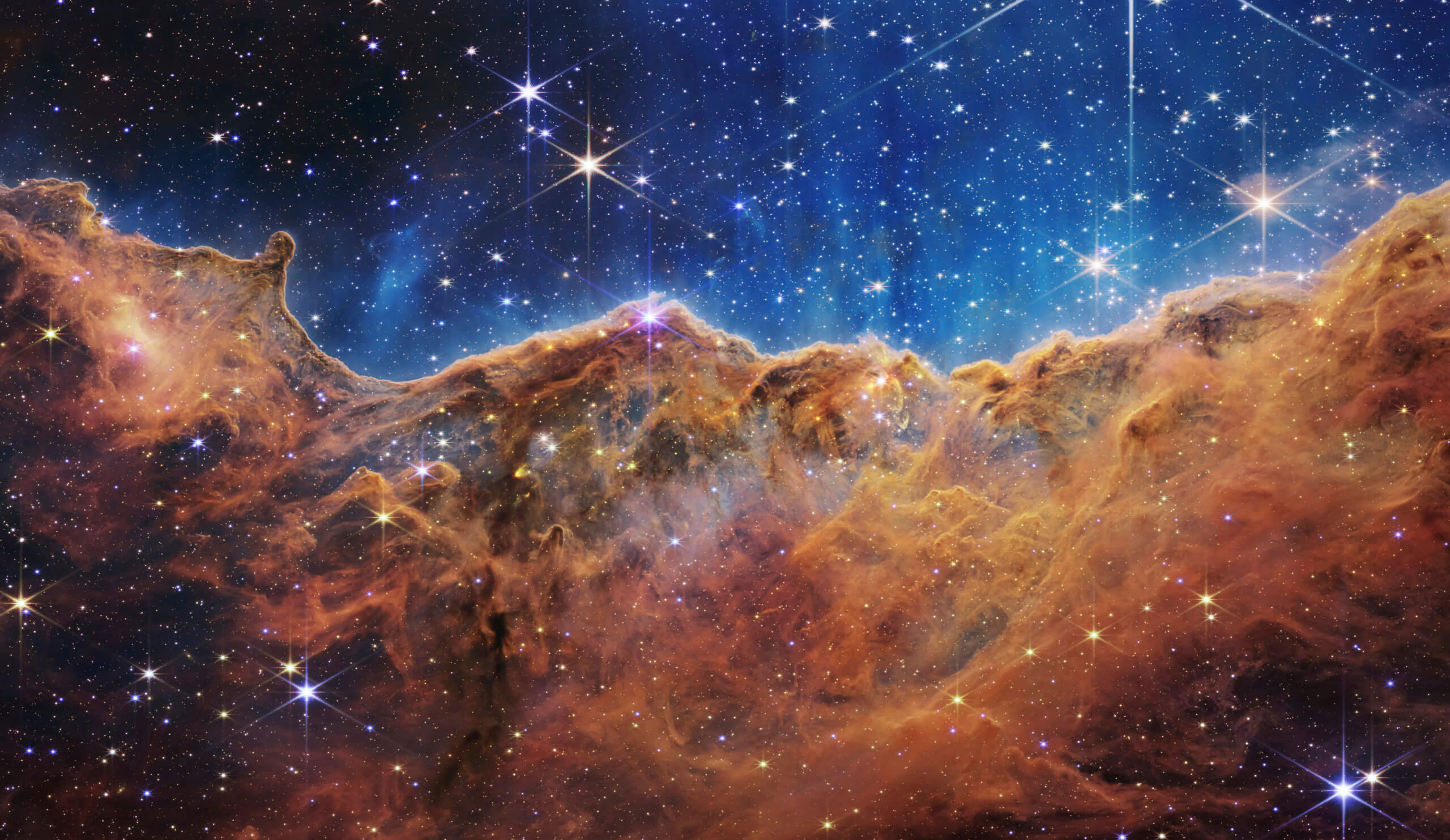
This image released by NASA on Tuesday, July 12, 2022, shows the edge of a nearby, young, star-forming region NGC 3324 in the Carina Nebula. Captured in infrared light by the Near-Infrared Camera (NIRCam) on the James Webb Space Telescope, this image reveals previously obscured areas of star birth, according to NASA. (NASA, ESA, CSA, and STScI via AP)
The James Webb Space Telescope is the largest and most powerful space observatory ever launched. Yesterday, NASA unveiled a series of high-resolution color images revealing what it describes as “cosmic cliffs,” “galaxy evolution,” a “dying star’s final ‘performance,’” and the “steamy atmosphere of a distant planet in detail.”
NASA administrator Bill Nelson described the significance of this ongoing work: “Put simply, Webb will give humanity a new view of space and fundamentally alter our understanding of the universe.”
The more we learn about a work of art, the more we learn about the artist. The better we understand a musical composition, the better we understand and can appreciate the composer.
In the same way, the more we learn about the vastness and complexity of creation, the more we learn about the vastness and complexity of the Creator. Rather than disproving or rendering irrelevant the biblical worldview, scientific discoveries continue to show the genius of the One whose work they study.
NASA scientist Robert Jastrow famously wrote in God and the Astronomers, “For the scientist who has lived by his faith in the power of reason, the story ends like a bad dream. He has scaled the mountains of ignorance, he is about to conquer the highest peak; and as he pulls himself over the final rock, he is greeted by a band of theologians who have been sitting there for centuries.”
Why doesn’t God always do what he sometimes does?
However, the “book of nature” is not uniform in its message. We learn from the immensity of space the infinitude of our Father. We see in the microscopic design of a leaf the brilliance of its Designer.
But we also find much in nature that seems to contradict faith in an all-knowing, all-powerful, all-loving Creator. For example, today’s Wall Street Journal reports that the COVID-19 BA.5 subvariant is “circulating widely” and “elevates the risk of reinfections and rising case counts.” Meanwhile, yet another variant called BA.2.75 “may be able to spread rapidly and get around immunity from vaccines and previous infection,” according to the Associated Press.
A recent study reports that COVID-19 caused one in eight deaths in the US between March 2020 and October 2021. The ongoing pandemic threatens everyone, not just older adults: In 2021, it was the leading cause of death in adults aged forty-five to fifty-four and the fourth-leading cause for those aged fifteen to thirty-four.
As a theologian, I would respond by noting that our world “fell” in the “Fall” (Romans 8:22), producing diseases and disasters that were not in the garden of Eden. Such consequences of sin are not the fault of our sinless Lord.
But a skeptic could counter: What about times when God intervenes in his fallen world? What about biblical miracles that stop diseases and plagues (cf. 2 Samuel 24:16), prevent natural disasters (cf. Matthew 8:23–27), and heal the sick (cf. Matthew 8:14–17) and raise the dead (cf. John 11:43–44)?
Since God can still do all he has ever done (cf. Malachi 3:6; Hebrews 13:8), why doesn’t he always do what he sometimes does?
“The waters rose up in a heap”
This week, we’ve been exploring ways to trust God when it’s hard to trust God. On Monday, we chose to remember our Lord’s provision in the past as we trust him with our needs in the present. Yesterday, we responded to his call to trust not in “chariots” and “horses” but in their Maker.
Today, let’s consider the fact that God’s timing is often confusing and frustrating to time-bound humans. Apparent denials or delays are actually manifestations of omniscient grace. If we knew what God knows, we would agree with what God does.
Here’s an example: I am reading through the book of Joshua in my personal Bible study these days and came upon the crossing of the flooded Jordan River, an event the ESV Study Bible calls “no less miraculous than crossing the Red Sea.”
The river, swollen by snowmelt from Mt. Hermon and spring rains, was impassible to the Jewish people as they sought to cross it to enter their Promised Land. However, God called their priests bearing the ark of the covenant to step into the river, promising that in that moment, “the waters of the Jordan shall be cut off from flowing, and the waters coming down from above shall stand in one heap” (Joshua 3:13).
This is precisely what happened: when the priests set foot in the river, “the waters coming down from above stood and rose up in a heap very far away, at Adam, the city that is beside Zarethan, and those flowing down toward the Sea of the Arabah, the Salt Sea, were completely cut off” (v. 16).
This occurred eighteen miles upstream from where the people were crossing. A flash flood typically moves at nine feet per second, which calculates to just over six miles per hour. In other words, God began stopping the flooded Jordan River three hours before the priests set foot on its banks.
When God’s timing is not ours
Let’s close where we began. Scientists estimate that there are two hundred billion trillion stars in the universe now being explored by the James Webb Space Telescope. And yet, our Father “determines the number of the stars; he gives to all of them their names” (Psalm 147:4).
Commenting on this fact, Charles Spurgeon observed, “He who counts the stars and calls them by their names is in no danger of forgetting his own children. He knows your case as thoroughly as if you were the only creature he ever made or the only saint he ever loved.”
It can be hard in hard times to believe that this is true, but Paul agreed: “Let us not grow weary of doing good, for in due season we will reap, if we do not give up” (Galatians 6:9, my emphasis). So did Peter: “Humble yourselves, therefore, under the mighty hand of God so that at the proper time he may exalt you, casting all your anxieties on him, because he cares for you” (1 Peter 5:6–7, my emphases).
What “anxieties” do you need to trust to the timing and grace of your Father today?
NOTE: I blog nearly every weekday and send multiple tweets with spiritual reflections throughout the day. You can read my newest blogs, “What’s wrong with biblical obedience?” and “How you can buy a ‘Star Wars’ Stormtrooper helmet,” on my personal website; I invite you to follow me each day on Twitter.














